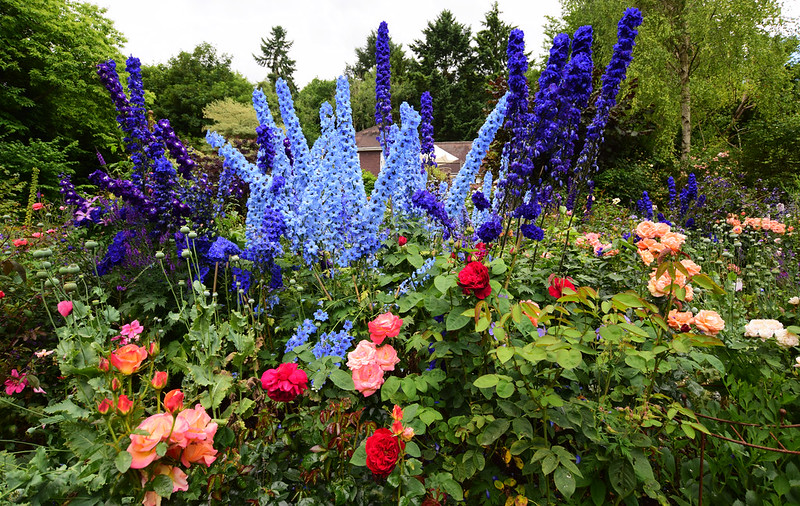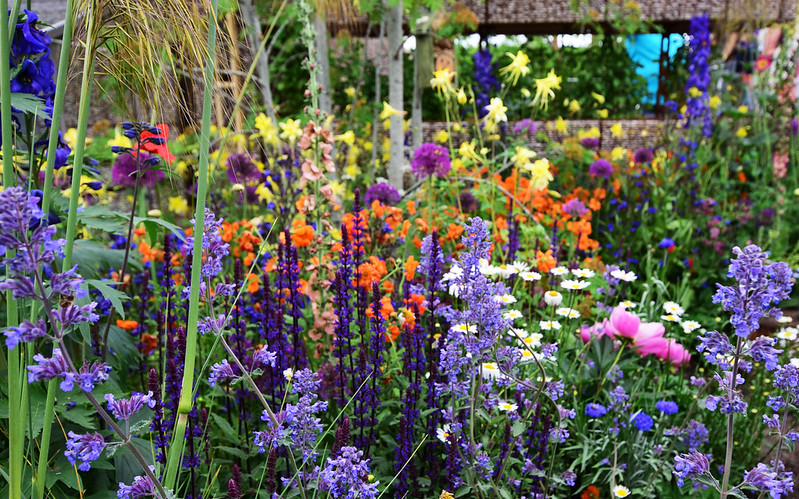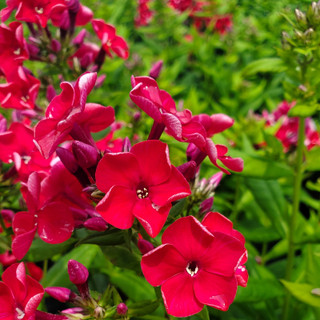Larkspur refers to both annual plants and perennials also known as delphiniums. They are members of the Ranunculaceae family of plants that includes clematis, hellebore, buttercups, and anemone. All of these plants grow in full sun to part shade and in well-draining, rich soil that retains moisture. Classic cottage gardens and cutting gardens often include at least one type of Larkspur.
Their tall flower spikes are perfect for the back of a mixed perennial border and attract several beneficial pollinators. Larkspur can be grown in any ornamental garden to entice pollinators, but should not be grown in edible or kitchen gardens, as every part of the plant is toxic to animals and humans.

Photo by Mark Wordy, unmodified, Flickr, copyright CC BY 2.0
Shrubs To Plant With Larkspur
Larkspur contrasts nicely with broadleaf evergreen shrubs in a mixed garden border. Tall growing rhododendrons, arborvitae, and yews highlight the upright form and height of delphinium and provide a solid backdrop for most of the growing season. Lower-growing heather, boxwood, and carpet roses can be planted at the front of a border as a ground cover to contrast or complement the cool blues and delicate pinks of Larkspur flowers.
Perennials To Plant With Larkspur
Perennials are the glue of a good garden design. They return year after year to fill in the space between shrubs and trees. Many different varieties can be used to bloom in waves from spring to the first frost of fall. Plant tall delphinium at the back of a border with other tall growers such as foxglove, phlox, joe pye weed, clematis, and Japanese anemone. For the next layer, select medium-height perennials such as daylily, shasta daisy, ornamental grasses, iris, poppies, salvia, and nepeta. Choosing plants in one or two colors will unify the whole design while accentuating different foliage textures and shapes.

Photo by Mark Wordy, unmodified, Flickr, copyright CC BY 2.0
Annuals To Plant With Larkspur
Annual and perennial Larkspurs can benefit from the often bright colors of annual bedding plants. Use annual poppies, cosmos, sunflowers, and snapdragons to enhance or contrast the calm deep blues and purples of Larkspur. The bright and cheerful colors of nasturtiums, pansies, begonias, and lobelia all look good next to Larkspur and bloom non-stop. Plant annuals in front of delphiniums to hide any tattered foliage and faded flowers later in the summer.
Best Companion Plants for Larkspur in Containers
Larkspurs make perfect companions in a mixed seasonal planter. Their height is often key to creating a polished container display. The fibrous roots of Larkspur are not aggressive and will happily grow alongside other perennials and annuals in a large container. Select pots with at least a 12 - 16-inch diameter when designing containers with Larkspur.
For a winning combination, plant a midnight blue Delphinium as the centerpiece, with a deep green fern and calibrachoa in pale lavender shades as filler plants, and complete the design with a silvery draping of Dichondra as a spiller. The cool colors paired with silvery foliage makes an elegant, long-lasting display.
Plants Not To Grow With Larkspur
Larkspur can grow well in either part shade or full sun, which means few plants are off limits. Avoid pairing them with streamside and aquatic plants, such as cattails, marsh marigolds, and water lilies. These plants require too much continuous moisture and are not compatible with Larkspur. Larkspur also should not be grown in the vegetable patch near edible plants. Because all parts of Larkspur are considered toxic for humans and animals, it is better to be safe and grow it away from any edible plants.

Photo by F.D. Richards, unmodified, Flickr, copyright CC BY-SA 2.0
Best Plants To Grow With Larkspur
Cottage garden plants are some of the best companions for Larkspurs. The casual but romantic style can be achieved in gardens of almost any size. Early spring bulbs look lovely next to the emerging foliage of Larkspur, and can be followed by foxgloves, bleeding hearts, ferns, and violas for spring color until the heat of early summer arrives. Phlox, hollyhocks, Shasta daisies, and clematis can add contrasting foliage and blooms, while well-loved shrubs like hydrangea, lilac, and forsythia provide a consistent green backdrop through the summer.
 |
Author Robbin Small - Published 9-21-2023 |




